A beginner's guide to investing in commodities
What is a commodity? The word is an umbrella term for economic goods that are “fungible” – that is, they can be freely bought and sold. Commodities produced by a country can be grouped across two broad categories: “soft” and “hard”.
Soft commodities are agricultural goods, livestock, grains, and a raft of raw materials that are grown rather than mined or extracted.
Hard commodities are those that we're focusing on in the following article – which are natural resources, such as metal ores (both precious and industrial metals) and oil reserves.
Such resources are critical to the economic health of nations, as we’re regularly reminded of amid global events – most recently, wars in the Middle East and Europe. That’s why any disruptions to the supply of commodities are watched so closely, as are changes in demand, which are used as a gauge of the economic health of countries.
The pricing variability created by such events is also why a sophisticated global investment industry has developed around the buying and selling of physical commodities.
All that glitters: The appeal of gold
The role of gold as a store of value dates back millennia and the precious metal has been prized since the beginning of recorded time. Gold even underpinned both the US and UK currencies until the 1970s and the 1930s, respectively, before being replaced by the US dollar and British pound sterling.
The first Futures contracts for gold became available via the Chicago Mercantile Exchange (CME) in 1974. Since then, the Commodities Exchange (COMEX), a division of CME, has become the world’s largest platform for the trading of not only gold but also platinum and industrial metals copper, aluminium and steel. It executes more than 400,000 futures and options contracts daily, making it the world’s most liquid metals exchange.
The price of gold is determined by the trading activity conducted via both COMEX and the London Bullion Market Association (LBMA).
COMEX gold price over five years
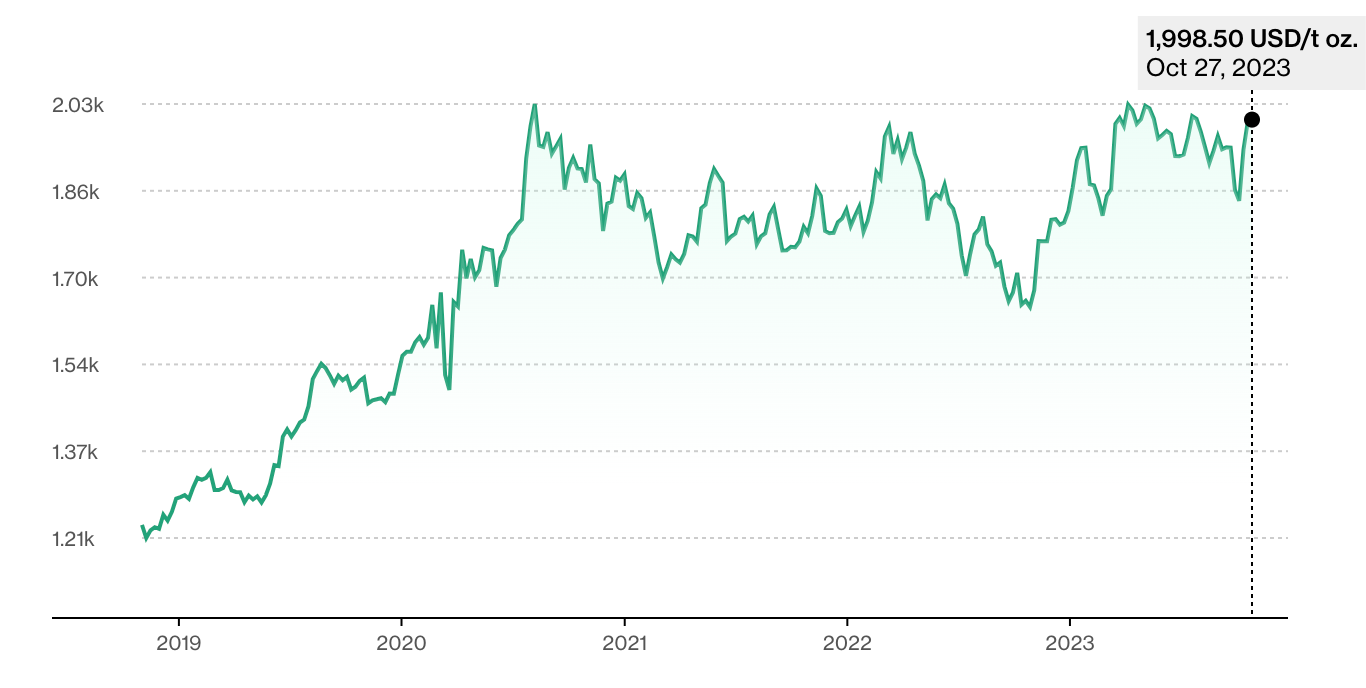
Driven by steel: Iron ore
An industry many Australians are familiar with, iron ore is one of the main contributors to our national GDP. Exports of iron ore are tipped to pull in around $120 billion in 2023-2024, according to the Australian Government’s Department of Industry, Science and Resources.
Steelmaking consumes around 95% of global iron ore production, with the supply-demand for the versatile metal key to its price movement over time. Global steel demand in 2023 is expected to hit just over 1,800 million tonnes, up 2.3% on last year.
The post-COVID demand recovery that had been underway was disrupted by several factors last year including rising inflation and the Russia-Ukraine war, which impacted activity in the fourth quarter.
“Persistent inflation and high-interest rates in most economies will limit the recovery of steel demand in 2023, despite positive factors like China’s reopening, Europe’s resilience in the face of the energy crisis, and the easing of supply chain bottlenecks,” the chair of the Worldsteel Economics Committee Maximo Vedoya said earlier this year.
How is iron ore priced?
The industry standard iron ore exchange is the New York Mercantile Exchange (NYMEX), which is also part of the Chicago Mercantile Exchange Group. Alongside other commodities, it tracks iron ore futures via the 62% Fe, CFR China metric, which prices metric tonnes in US dollars.
As Market Index notes, “Growth in China (the world's largest consumer of metals) has affected the price of iron ore so much recently that the spot price can almost be considered a proxy for China's economic health.”
NYMEX 62% Fe, CFR China price over five years
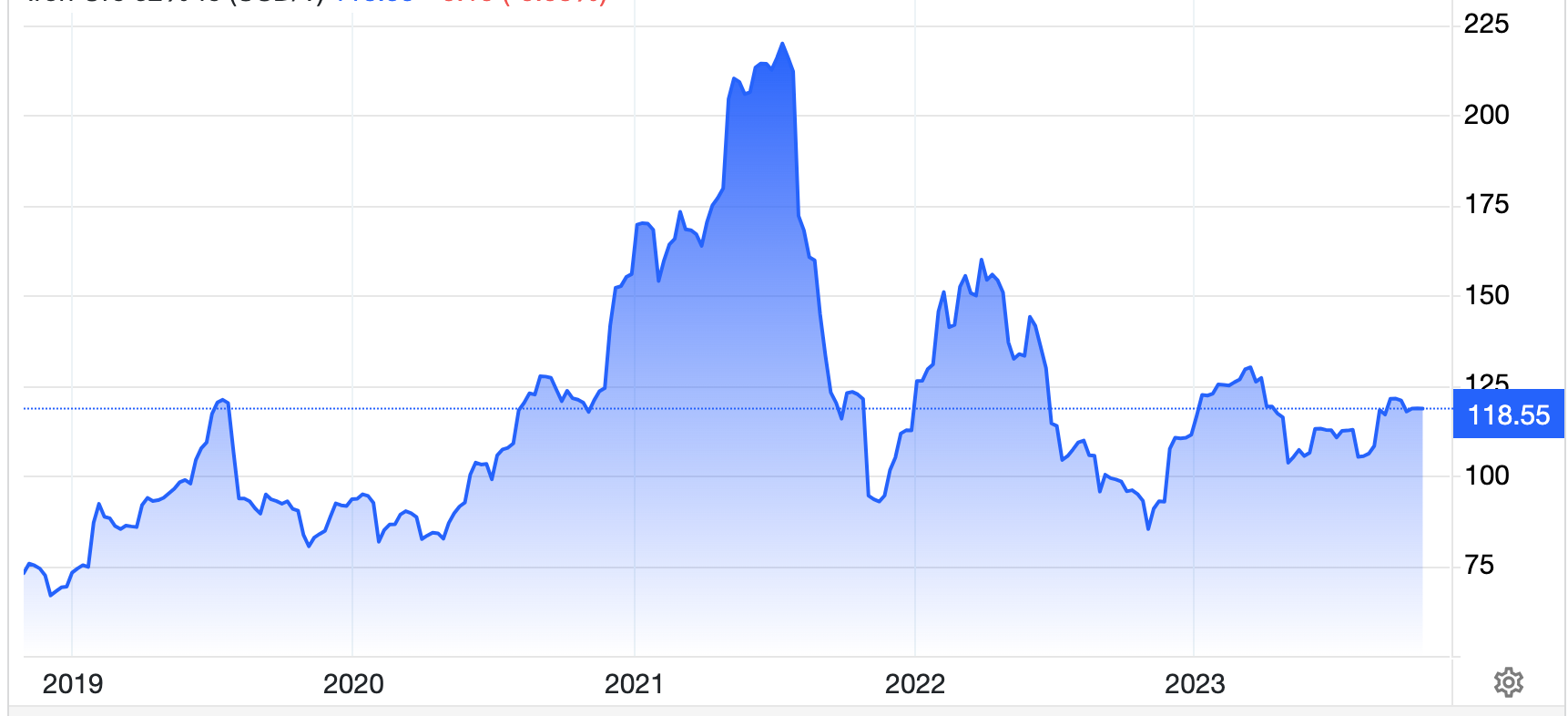
Energy supply: Coal, gas, and oil
Coal is another of Australia’s largest exports, second only to iron ore. It’s often linked closely with crude oil and natural gas as the largest (and dirtiest) energy-producing industries. Despite increasing input from other sources including natural gas and renewables, these comprise around two-thirds of global power generation.
Coal prices vary across two main types:
- Thermal coal, which is used in electricity generation.
- Coking or metallurgical coal, which is used primarily in steelmaking and usually trades at a premium versus thermal coal.
The benchmark coal price is published daily and is widely available from sources such as S&P Global Platts. Like most bulk commodities, transport costs, grade, and quality are important factors in determining the end price of coal.
Prices for both metallurgical and thermal coal remain elevated, at average prices of US$263 and US$180 in 2023, despite indications long-term demand has peaked, as outlined in the IEA’s latest report.
Recent years have been among the most volatile for coal prices, with both Newcastle and ARA prices hitting US$400 a tonne last March, when Russian forces rolled into Ukraine. Prices then fell steeply at the start of 2023 to around US$300 a tonne in April, before rebounding to a new record high of US$443 in September.
Newcastle coal futures over five years
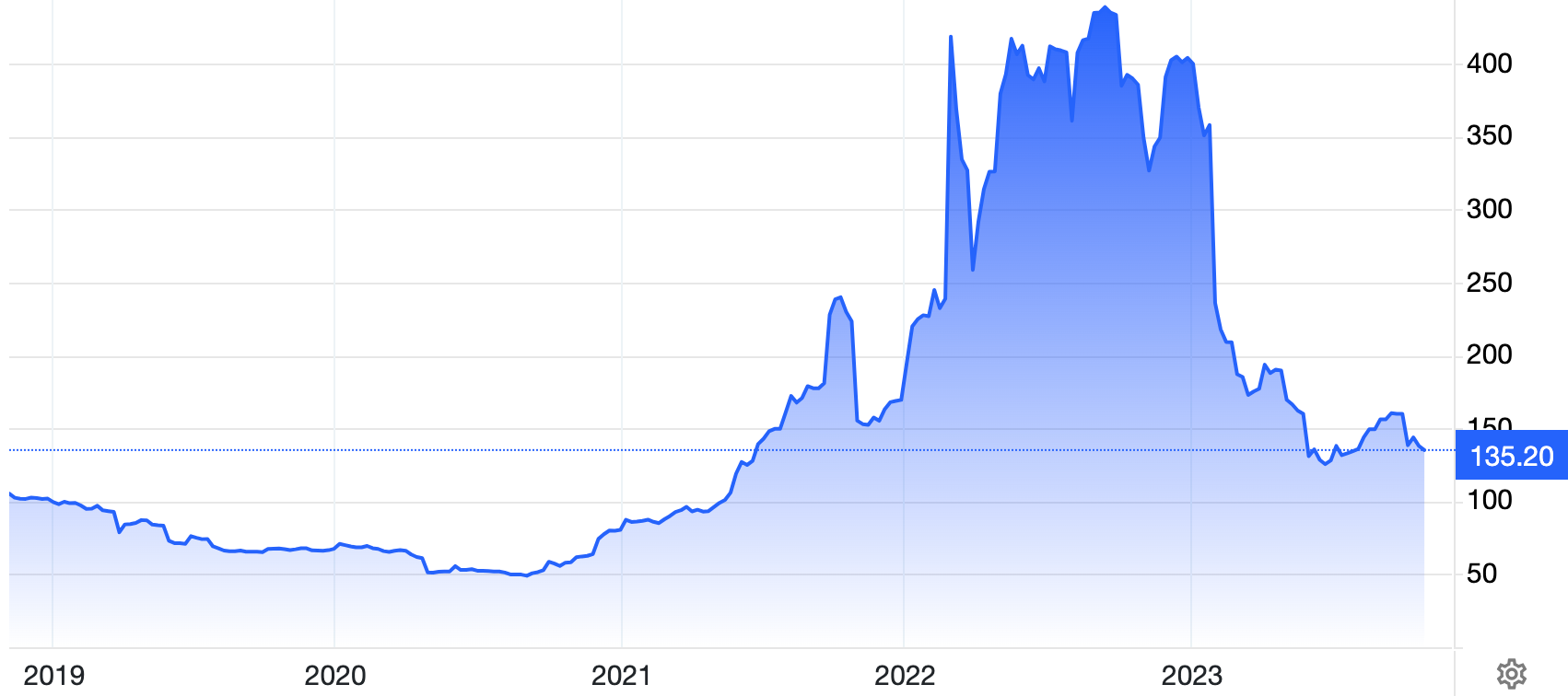
This volatility has been reflected in the share prices of Australia’s largest ASX-listed coal miners, such as Yancoal Australia (ASX: YAL), Whitehaven Coal (ASX: WHC) and New Hope Corporation (ASX: NHC).
Yancoal's share price over five years
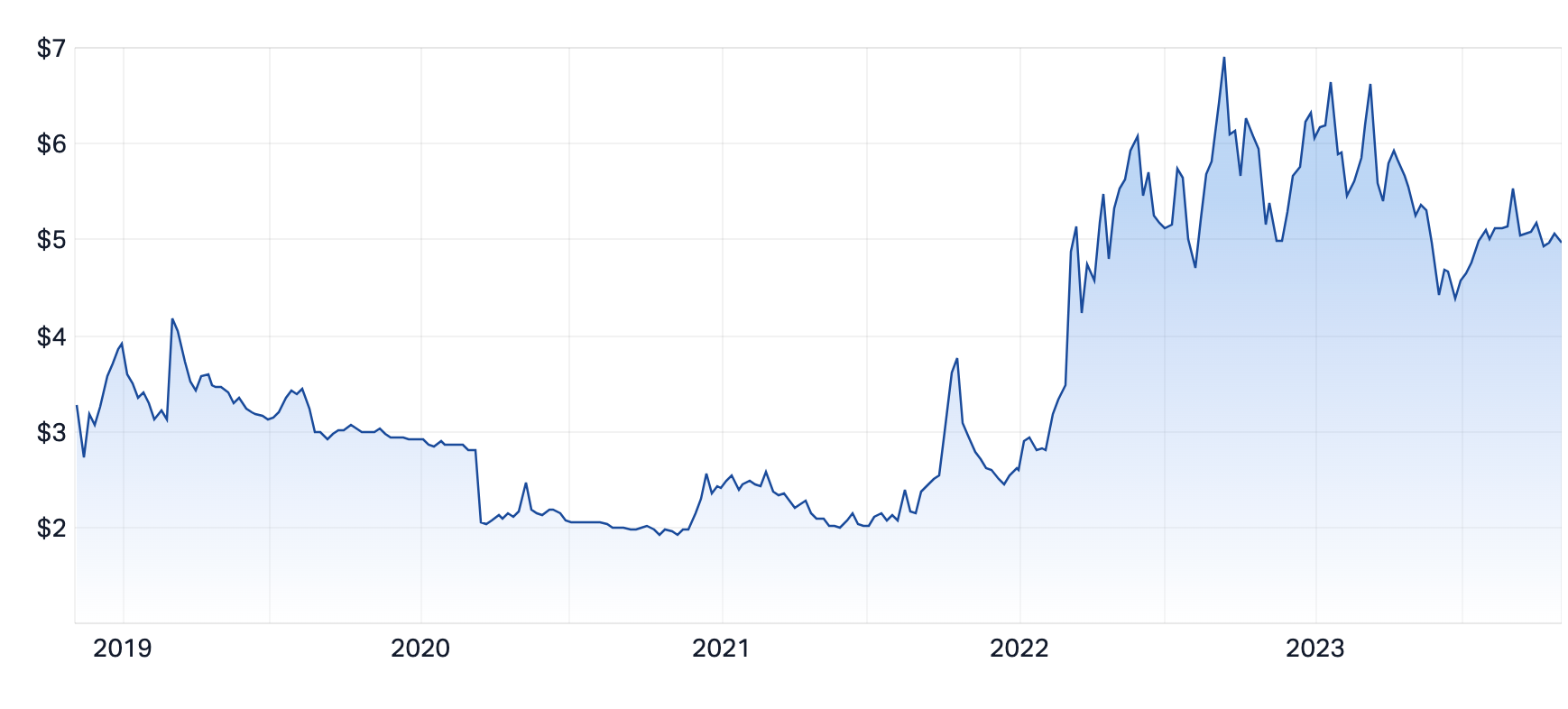
Whitehaven Coal's share price over five years
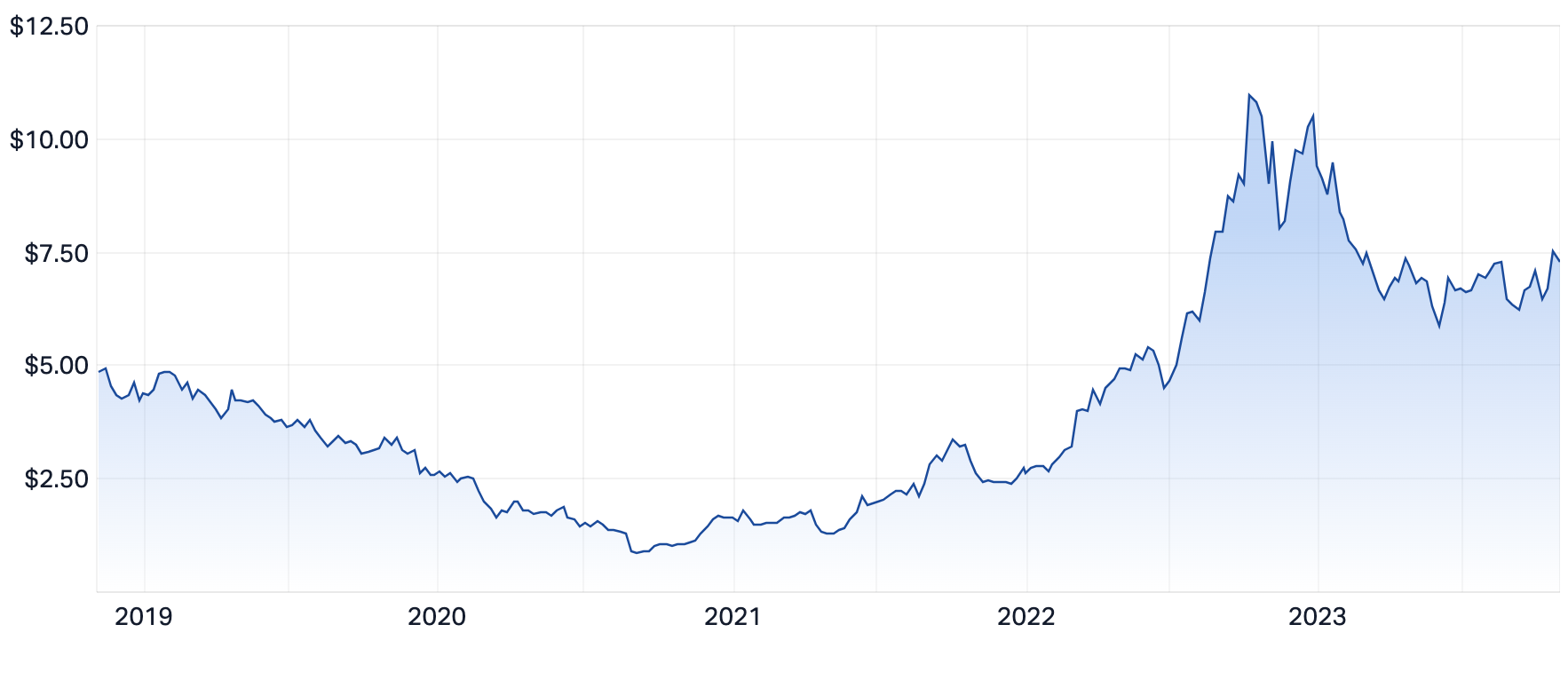
New Hope Corporation's share price over five years
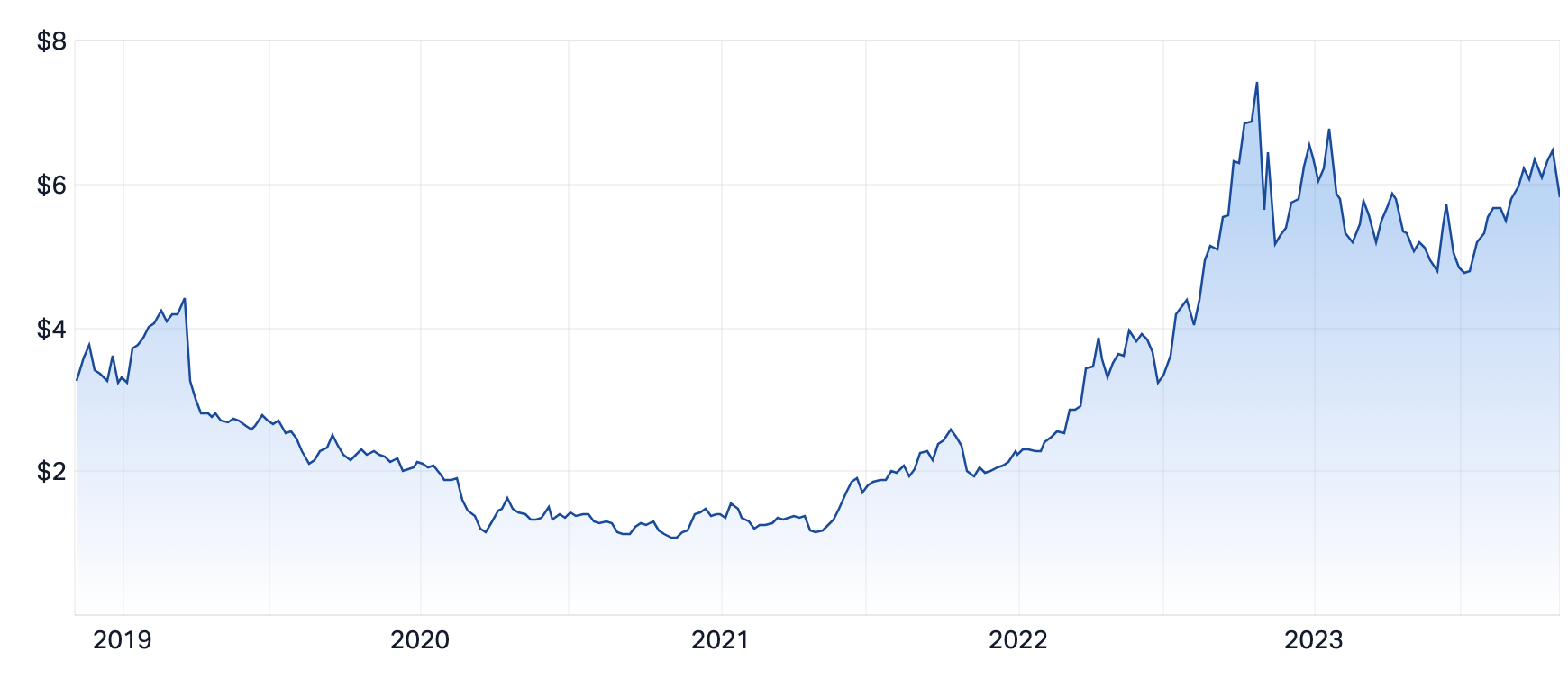
How to invest in commodities
Commodities investments involve buying and selling physical commodities, or financial instruments – including futures and options – that are based on the prices of underlying commodities. The second of these approaches is the most common because of the impracticality and expense of buying (and storing) barrels of oil and tonnes of iron ore or gold bars.
Futures trading: Futures are contracts that obligate holders to buy or sell a specified product at a set price on a future date and have traditionally been the most popular way to invest in assets such as precious metals, industrial metals, and energy commodities.
Commodities stocks: Buying shares in the underlying companies that produce (mine), process, or distribute commodities is another indirect way to invest. Materials is the second-largest sector on the ASX by market cap, with some 950 listed companies in the space after Financials, which comprises around 550 companies.
Noting that the S&P/ASX 200 Resources Index (ASX: XJR) has risen around 21% in the last two years, my colleague Ally Selby recently discussed some of the individual stocks that have underpinned this performance.
But for investors seeking an alternative, perhaps as an entry point to commodities investing, numerous exchange-traded funds provide exposure.
A passive approach to commodities
ETFs generally aim to track benchmark indices that measure the price of single commodities, a basket of commodities, or futures contracts across one or more commodities. This provides exposure without the cost or complexity of trading futures contracts or other derivatives.
What makes commodity ETFs different
Unlike traditional ETFs, which can be thought of as baskets of stocks, these products generally invest their assets in cash. The ETF provider then enters “swap contracts” with one or more counterparties to gain exposure to the performance of futures for the underlying commodity. (A swap contract is a derivative contract where one party exchanges or "swaps" the cash flows or value of one asset for another).
These products are often described as “synthetic” because their returns aren’t linked directly with an underlying company or commodity. Such ETFs can be riskier because they introduce commodity volatility risk, commodity roll risk, and derivatives risk to your portfolio – all of which mean the investment value can rise and fall.
Some examples include:
Betashares Crude Oil ETF (ASX: OOO)
- Performance: This has varied widely, in line with volatility in the futures market. The return over one, three, and five years is 18.91%, 38.27%% and -11.28%.
- Total assets: $153.34 million
- Launch date: 11 November 2011
- What it costs: 1.29% p.a.
- Summary: OOO tracks the US-dollar S&P GSCI Crude Oil Index Excess Return.
Global X Bloomberg Commodity ETF (ASX: BCOM)
- Performance: 9.67% (since inception)
- Total assets: $30.45 million
- Launch date: 5 July 2023
- What it costs: 0.6% p.a.
- Summary: Investing in the Bloomberg Commodity Index Excess Return 3 Month Forward, this ETF provides broad exposure to a highly liquid, broad basket of commodities – both hard and soft – including energy, precious metals, industrial metals, livestock, and grains.
Other commodities ETFs invest in the physical assets themselves, including:
Betashares Gold Bullion ETF - Currency Hedged (ASX: QAU)
- Performance: 8.91%, -2.31% and 7.14% over one, three, and five years.
- Total assets: $507.35 million
- Launch date: 3 May 2011
- What it costs: 0.59% p.a.
- Summary: This ETF is backed by physical gold bullion. It aims to track the performance of the price of gold, hedged for currency movements in the US dollar and Australian dollar exchange rate (before fees and expenses).
GlobalX Physical Gold ETF (ASX: GOLD)
- Performance: 21.17%, 5.01% and 11.91% over one, three and five years.
- Total assets: $2.83 billion
- Launch date: 28 March 2003
- What it costs: 0.4% p.a.
- Summary: Backed by physical gold bullion, each bar is segregated, individually identified, and allocated by HSBC Bank in London. The vault is audited twice annually to ensure the bullion meets the required specifications.
VanEck Gold Bullion ETF (ASX: NUGG)
- Performance: 9.84% (since inception)
- Total assets: $42.96 million
- Launch date: 5 December 2022
- What it costs: 0.25% p.a.
- Summary: NUGG invests solely in physical gold bullion sourced from Australia.
How do you invest in commodities?
Let us know in the comments section below.
2 topics
8 stocks mentioned
3 funds mentioned
1 contributor mentioned

